Related Research Articles

The Watergate scandal was a political scandal in the United States involving the administration of President Richard Nixon from 1972 to 1974 that led to Nixon's resignation. The scandal stemmed from the Nixon administration's attempts to cover up its involvement in the June 17, 1972, break-in of the Democratic National Committee headquarters at the Washington, D.C., Watergate Office Building.

All the President's Men is a 1974 non-fiction book by Carl Bernstein and Bob Woodward, two of the journalists who investigated the June 1972 break-in at the Watergate Office Building and the resultant political scandal for The Washington Post. The book chronicles the investigative reporting of Woodward and Bernstein from Woodward's initial report on the Watergate break-in through the resignations of Nixon Administration officials H. R. Haldeman and John Ehrlichman in April 1973, and the revelation of the Oval Office Watergate tapes by Alexander Butterfield three months later. It relates the events behind the major stories the duo wrote for the Post, naming some sources who had previously refused to be identified for their initial articles, notably Hugh Sloan. It also gives detailed accounts of Woodward's secret meetings with his source Deep Throat, whose identity was kept hidden for over 30 years. Gene Roberts, the former executive editor of The Philadelphia Inquirer and former managing editor of The New York Times, has called the work of Woodward and Bernstein "maybe the single greatest reporting effort of all time."

Harry Robbins "Bob" Haldeman was an American political aide and businessman, best known for his service as White House Chief of Staff to President Richard Nixon and his consequent involvement in the Watergate scandal.

Nixon is a 1995 American epic historical drama film directed by Oliver Stone, produced by Clayton Townsend, Stone, and Andrew G. Vajna. The film was written by Stone, Christopher Wilkinson, and Stephen J. Rievele, with significant contributions from "project consultants" Christopher Scheer and Robert Scheer. The film tells the story of the political and personal life of former U.S. President Richard Nixon, played by Anthony Hopkins.

The Committee for the Re-election of the President, abbreviated CRP, but often mocked by the acronym CREEP, was, officially, a fundraising organization of United States President Richard Nixon's 1972 re-election campaign during the Watergate scandal. In addition to fundraising, the organization also engaged in political sabotage against Nixon's opponents, the various Democratic politicians running in the election.

Jeb Stuart Magruder was an American businessman and high-level political operative in the Republican Party who served time in prison for his role in the Watergate scandal.

John Daniel Ehrlichman was an American political aide who served as the White House Counsel and Assistant to the President for Domestic Affairs under President Richard Nixon. Ehrlichman was an important influence on Nixon's domestic policy, coaching him on issues and enlisting his support for environmental initiatives.

Louis Patrick Gray III was acting director of the Federal Bureau of Investigation (FBI) from May 3, 1972, to April 27, 1973. During this time, the FBI was in charge of the initial investigation into the burglaries that sparked the Watergate scandal, which eventually led to the resignation of President Nixon. Gray was nominated as permanent Director by Nixon on February 15, 1973, but failed to win Senate confirmation. He resigned as Acting FBI director on April 27, 1973, after he admitted to destroying documents that had come from convicted Watergate conspirator E. Howard Hunt's safe—documents received on June 28, 1972, 11 days after the Watergate burglary, and given to Gray by White House counsel John Dean.

Deep Throat is the pseudonym given to the secret informant who provided information in 1972 to Bob Woodward, who shared it with Carl Bernstein. Woodward and Bernstein were reporters for The Washington Post, and Deep Throat provided key details about the involvement of U.S. president Richard Nixon's administration in what came to be known as the Watergate scandal. In 2005, 31 years after Nixon's resignation and 11 years after Nixon's death, a family attorney stated that former Federal Bureau of Investigation (FBI) Associate Director Mark Felt was Deep Throat. By then, Felt was suffering from dementia and had previously denied being Deep Throat, but Woodward and Bernstein then confirmed the attorney's claim.

John Wesley Dean III is an American attorney who served as White House Counsel for U.S. President Richard Nixon from July 1970 until April 1973. Dean is known for his role in the cover-up of the Watergate scandal and his subsequent testimony to Congress as a witness. His guilty plea to a single felony in exchange for becoming a key witness for the prosecution ultimately resulted in a reduced sentence, which he served at Fort Holabird outside Baltimore, Maryland. After his plea, he was disbarred.

The White House Plumbers, sometimes simply called the Plumbers, the Room 16 Project, or more officially, the White House Special Investigations Unit, was a covert White House Special Investigations Unit, established within a week of the publication of the Pentagon Papers in June 1971, during the presidency of Richard Nixon. Its task was to stop and/or respond to the leaking of classified information, such as the Pentagon Papers, to the news media. The work of the unit "tapered off" after the bungled "Ellsberg break-in" but some of its former operatives branched into illegal activities while still employed at the White House together with managers of the Committee to Re-elect the President, including the Watergate break-in and the ensuing Watergate scandal. The group has been described as Nixon's "fixers".
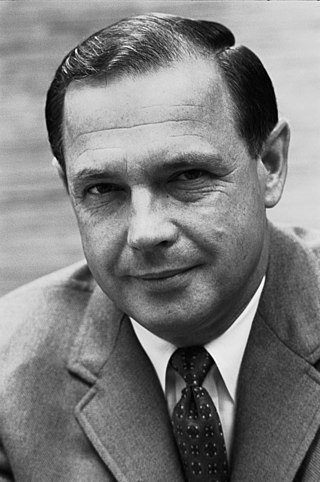
Alexander Porter Butterfield is a retired United States Air Force officer, public servant, and businessman. He served as the deputy assistant to President Richard Nixon from 1969 to 1973. He revealed the White House taping system's existence on July 13, 1973, during the Watergate investigation but had no other involvement in the scandal. From 1973 to 1975, he served as administrator of the Federal Aviation Administration.
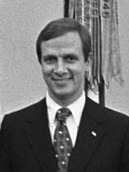
Gordon Creighton Strachan is an American attorney and political staffer who served as an aide to H.R. Haldeman, the chief of staff for President Richard Nixon and a figure in the Watergate scandal.
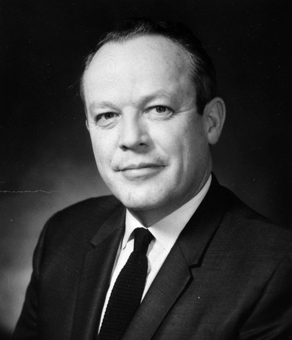
Richard Gordon Kleindienst was an American lawyer, politician, and U.S. Attorney General during the early stages of Watergate political scandal.

The Watergate Seven has come to refer to two different groups of people, both of them in the context of the Watergate scandal. Firstly, it can refer to the five men caught on June 17, 1972, burglarizing the Democratic National Committee's headquarters in the Watergate complex, along with their two handlers, E. Howard Hunt and G. Gordon Liddy, who were Nixon campaign aides. All seven were tried before Judge John Sirica in January 1973.

The Watergate scandal refers to the burglary and illegal wiretapping of the headquarters of the Democratic National Committee, in the Watergate complex, by members of President Richard Nixon's re-election campaign and the subsequent cover-up of the break-in resulting in Nixon's resignation on August 9, 1974, as well as other abuses of power by the Nixon White House that were discovered during the course of the scandal.

Francis Donald Nixon was a younger brother of U.S. President Richard Nixon.
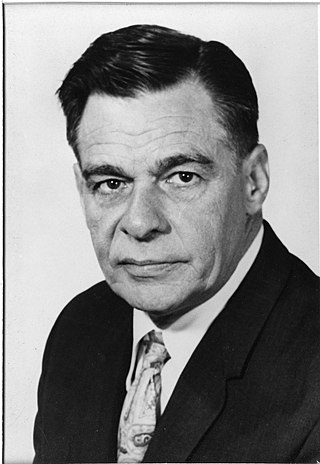
Henry E. Petersen was an attorney and United States federal government official. He served as Assistant U.S. Attorney General during the Richard Nixon and Gerald Ford administrations. He also engaged in ethically questionable communications with Nixon and his staff, providing inside information about the Watergate investigation prior to the appointment of the Special Prosecutor.
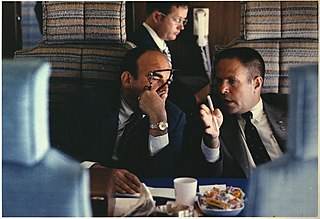
Operation Sandwedge was a proposed clandestine intelligence-gathering operation against the political enemies of U.S. President Richard Nixon's administration. The proposals were put together by Nixon's Chief of Staff H. R. Haldeman, domestic affairs assistant John Ehrlichman and staffer Jack Caulfield in 1971. Caulfield, a former police officer, created a plan to target the Democratic Party and the anti-Vietnam War movement, inspired by what he believed to be the Democratic Party's employment of a private investigation firm.
Blind Ambition is a four-part American miniseries that aired on CBS from May 20, 1979 to May 23, 1979 focusing on the Watergate coverup and based on the memoirs of former White House counsel John Dean and his wife Maureen.
References
- ↑ Marchetti, Victor (August 14, 1978). "CIA to 'Admit' Hunt Involvement in Kennedy Slaying" (PDF). The Spotlight . pp. 4–6. Archived (PDF) from the original on September 18, 2021. Retrieved February 17, 2023.
- ↑ "720 F2d 631 Hunt v. Liberty Lobby Dc". OpenJurist. November 28, 1983. Retrieved July 13, 2016.
- ↑ "Escaping the limited hangout". Global Intel Hub. July 12, 2022. Retrieved July 20, 2022.
- ↑ Frost, David; Nixon, Richard (1977). Frost/Nixon: The Complete Interviews . Paradine Television.
- ↑ Safire, William (March 26, 1989). "On Language; In Nine Little Words". The New York Times Magazine . Retrieved June 23, 2013.
- 1 2 "Transcript of a recording of a meeting among the President, John Dean, John Ehrlichman, H.R. Haldeman, and John Mitchell on March 22, 1973 from 1:57 to 3:43 p.m." History and Politics Out Loud. Archived from the original on January 4, 2004. Retrieved August 27, 2006.
- ↑ Carroll, Jon (May 1, 2002). "The Richard Nixon playbook". San Francisco Chronicle . Retrieved August 27, 2006.
- ↑ Wexler, Stuart; Hancock, Larry (2018). Killing King: Racial Terrorists, James Earl Ray, and the Plot to Assassinate Martin Luther King Jr. Catapult. p. 201. ISBN 978-1-64009-022-4 . Retrieved April 10, 2022.
- ↑ Ebrahim, Zahir (2012). The Poor-Man's Guide to Modernity (PDF) (3rd ed.). Project Humanbeingsfirst. p. 20.
- ↑ McGrory, Mary (April 25, 2002). "From Rome, A 'Limited Hangout'". The Washington Post . p. A29. Retrieved April 30, 2010.